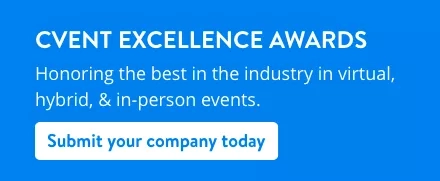Conferences don’t look the same as they used to. Once in-person, week-long planning marvels, they’ve now transitioned to the digital world. While global circumstances have caused this change, benefits of virtual conferences have emerged that were not understood before and there are now virtual conference best practices to follow to make the most of your event. Benefits like higher attendance, greater accessibility, wide-reaching brand awareness, better and re-playable content, virtual conferences have proven that they are worthy of a spot in your event program playbook.
In the future, that may mean an increase in hybrid events as in-person events return, carefully merging virtual and in-person events to get the benefits of both. Make your virtual conferences better, Top 10 hacks by Forbes. As you plan your next virtual conference and become virtual experience expert, here are sixteen virtual conference best practices to consider.
Set a clear virtual conference purpose
This shouldn’t be news. Every event you plan, whether in-person, virtual, or hybrid, must center around a clear purpose. Virtual conferences especially require a well-articulated purpose as it will guide the production of the event, technology required, and content created.
Determine your virtual conference purpose at the very beginning of the planning process. This purpose could be to educate, network, gather leads, or increase brand awareness, but don’t try to do too much.
Identify your target audience
Who do you want to attend your virtual conference? Identify your target audience when you set your virtual conference purpose. This will guide your marketing efforts, who you choose to speak at the event, and the overall design of the event.
Remember, when you go virtual, you can reach more people you might not have been able to with an in-person event. Geographic location is no longer a determining factor for attendance. If you are going global, make sure that you take time zones, languages, and other factors into consideration.
Build a winning event planning team
Digital events have changed many things, one of which is the structure of the planning team. In the past, planning and marketing teams were siloed, working independently on in-person events and webinar programs. As events moved online, those teams saw the need to join together. Merging your marketing and planning teams to plan virtual conferences allows both to leverage their skills.
Marketers can use the techniques developed from building goal-crushing webinar programs and planners can utilize their logistics and event acumen to create a successful event. Your virtual conference dream team should involve logistics, production, technology, demand gen, digital marketing, and martech.
Find out more about the benefits of merging your marketing and planning teams.
Choose the right virtual conference technology/software
A virtual conference requires a greater investment in technology. Once you have a clear event purpose and an understanding of content needs, you’ll be able to determine what kind of virtual event solution you’ll need. There are many kinds out there, some as simple as a video streaming option, others that are part of an entire event marketing and management platform.
Your event needs will determine what you require, but at a minimum, you’ll need registration, email marketing, streaming capabilities, content storage. Additionally, you should have ways for attendees to engage, such as virtual trade show booths, appointments, chat, Q&A, and surveys.
Create an easily navigable registration website
Your virtual conference registration website is the go-to place for potential attendees, sponsors, and exhibitors to find information on your virtual conference. These virtual event websites often act as a hub for the event later on, so building a website that has a clean design, is easy to search, and accessible on computer and mobile is important.
The most important items to include on your registration website.
- Virtual conference name, purpose, and branding
- An agenda that includes dates, times, and highlights keynotes and general sessions
- Cost of the conference – if there is one
- How to access content during and after the event
- Contact information and FAQs
Market your virtual conference
The virtual event space is crowded. It can be challenging to get the word out about your conference with so many competing events. Email marketing is a great way to target your audience. Create a tiered invite system to draw interest. Additionally, use social media, digital ads, and employee advocates to raise awareness about the event and drive interest.
With a virtual conference, getting a registration is not the hardest part – especially if the event is free. The next step? Getting the attendees that registered to show up on the day. That means creating an engaging email campaign, setting challenges on social media, and maintaining buzz about the event.
Find virtual conference sponsors and exhibitors
In terms of cost, virtual conferences are still finding their way. It’s unclear what the best pay model is for attendees, which can make budgeting the event challenging. Increasing your sponsorship dollars is the quickest way to impact your bottom line.
Create sponsorship packages that align with sponsor goals and objectives. Tiers are a great way to offer various levels for sponsors. The most common reasons for sponsorship are direct audience engagement and brand awareness. Sponsors will care most about the cost and if it equals the perceived value of sponsorship, while you will need to consider the required effort involved.
Invest in swag for attendees
Just because your events aren’t in-person doesn’t mean that swag has to go away. There’s nothing attendees love more than free stuff. Whether direct mail or digital gifts, look to partner with sponsors to give your attendees some swag. Some popular items are coffee or meal vouchers, snacks, mugs, face masks, and free or discounted exercise classes.
Find unique ways to engage attendees
Distractions are prevalent during virtual conferences. The internet, work, and family are all nearby and ready to steal the attention of your attendee’s. To cut distractions, put a greater emphasis on attendee engagement.
Leverage virtual event technology tools like Q&A, chat, and more during sessions. Set up networking events that break up the day and provide a way for attendees to interact that doesn’t involve staring at the screen without moving or speaking. For more, read tips for attending a virtual conference.
Up the production-level of general sessions and keynotes
While highly produced sessions can be expensive, they might be worth it. If you can’t afford to have experts produce all of your sessions, focus on general sessions and keynotes. The most important sessions deserve a little extra work to entertain attendees.
Hire a professional emcee
One thing virtual conferences often miss is the opportunity to connect sessions, keynotes, and networking together so that they don’t feel disjointed. A professional emcee can solve this. By hiring someone to give announcements, lead Q&A sessions, and start and end popular sessions, you can infuse humor and fun into the conference.
When looking for the right emcee, think about the tone of your event. Do you need someone serious or silly? Your emcee will be the most visible person at the event. Choose someone who understands your industry and the pain points of your attendees.
Facilitate networking sessions between attendees and sponsors
Build breakout sessions, appointments, and networking events into your agenda. One of the main benefits for sponsors is gathering leads at your event. it’s up to you to create those lead-gathering opportunities.
In addition to sponsors and exhibitors, attendees want to connect with other attendees. Offer happy hours, breakouts during sessions, or chances for attendees to meet and talk.
Prepare virtual conference speakers with tips and tech
No one likes to watch a session with crackling audio or a dimly lit speaker. Send your speakers the tech they need or a list of items to buy before the event and do a practice with them to ensure they understand how to use it.
To set a speaker up for success, send them: a microphone, a camera, a ring light, tips on how to set up their background and what to wear, a piece of conference swag to place in the frame during their session.
Use data and analytics to measure virtual conference success
Virtual events may determine success differently than in-person ones but reviewing wins and misses after the event is still important. Session attendance, attendee engagement, and leads gathered will always be key factors to analyze.
Other data to look at? Time in session, engagement with the session, tech success, and survey results during and after the event.
Record sessions and make them available after the event
At a virtual conference, every session, every keynote, every speaker is recorded. You can choose to make sessions available after the fact for attendees who missed them, or you can add them to your demand generation strategies.
Leverage your content. Use popular sessions as webinars after the virtual conference to engage a new set of prospects. Think about repurposing sessions into eBooks, infographics, or blogs to engage on a different level.
Have a support team in place and ready to address technical issues
This is a biggie. While your planning team might understand the ins and outs of your virtual event software, they aren’t a technology master. Set up a support team in case you have issues with your internet, with streaming, with yourvirtual conference platform , and with anything else that would take a true expert to fix.
We all know that Murphy’s Law is in full effect at events. What can go wrong, will go wrong. Find a support team that is knowledgeable, experienced, and allows open lines of communication.
Want more best practices? Check out the Cvent Community.
A successful virtual conference
With these virtual conference best practices, you have the tips you need to plan a great event. Remember, when planning always put yourself in the attendee’s shoes. Consider their point of view and needs as you build out your event, as well as the needs of sponsors, exhibitors, and your organization.
Want more? Read Virtual Conference 2022: Ideas, Tips, and Tools







